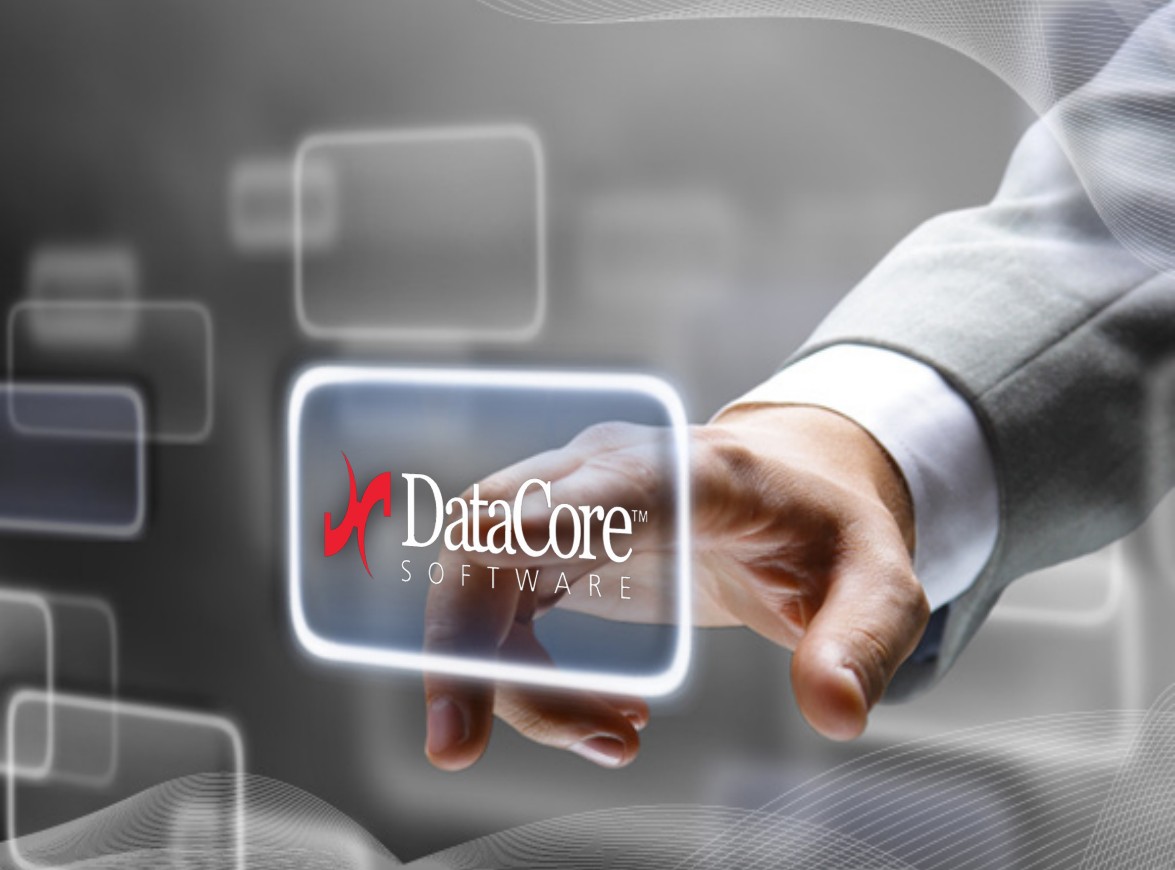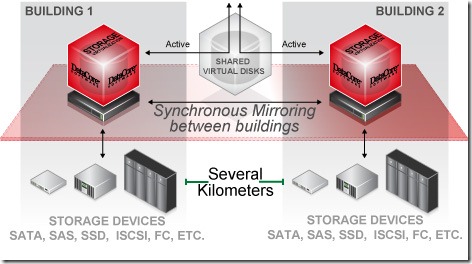 DataCore, quite simply, delivers the most flexible and most powerful SAN solution available for small businesses needing 1TB of 1Gbe iSCSI storage , through to large enterprises requiring 100’s of Terabytes, requiring multiple 8Gbps Fibre Channel connections.
DataCore, quite simply, delivers the most flexible and most powerful SAN solution available for small businesses needing 1TB of 1Gbe iSCSI storage , through to large enterprises requiring 100’s of Terabytes, requiring multiple 8Gbps Fibre Channel connections.
If your needs are:
- High Availability Storage
- Split across Two locations (e.g. across campus environments)
- With no single point of failure
–then DataCore is the ideal solution.
How do I use it?
In 99% of DataCore implementations, DataCore is configured as:
- two (or more) entirely separate ‘DataCore Nodes’
- that might reside in the ‘same rack’
- or preferably, are stretched across 1Gbe, or 10Gbe into different racks
- or maybe across a Campus environment
- or even across a Fibre Link, across town, potentially up to a distance of 30Km
- the DataCore nodes mirror each other in perfect unison and lock-step
- to create a non-stop Storage Cluster
- for those that can hark back to days old in the IT Industry, think of Tandem Non-Stop and Sequent Shared Memory Compute architectures
What does it Cost:
Yet, DataCore starts, fully featured, at a few thousand pound for an entry level solution.
Flexibility
DataCores greatest strength is the total flexibility it provides end-users in how their SAN will be deployed.
- As DataCore is a ‘Node’ based solution, users get to choose whatever type of Physical storage they like to deploy behind the DataCore nodes
- Do you want to use JBOD, with SAS cable attach
- Do you want to use a new high performance (IBM, HP, HDS or other) SAN behind one Node,
- but redeploy an older HP SAN behind the ‘other’ DataCore Node
DataCores sheer flexibility is also makes defining the technologies ‘use cases’ somewhat difficult – it truly is the Swiss Army knife of Storage, but is unique: –
– rather than being a compromise of features, it provides world beating Best in Class Synchronous Mirroring, Performance, Thin Provisioning
Does ‘it’ Perform
DataCore use’s a stretched memory synchronous ‘Mega-RAM’ cache across the DataCore nodes.
Where as a typical SAN from HP, IBM or other may have 2GB, 4GB, or even 16GB per ‘active’ controller within the SAN chassis, DataCOre can be configured with 32GB, 64GB…up to 1Terabyte of nano-second level writeback acknowledgment RAM.
What this means is DataCore will typically accelerate Random IOP performance of the underlying storage by at least a factor of two.
In many cases, for specific data sets, Storage IO acceleration can be 5 to 10 times that of the underlying storage.
With ‘Mega’ RAM caches, entire SQL Databases or their Log and Join Tables can be cached in memory – and the same would equally apply to other high IO datasets, such as Exchange Logs.
Case Studies
The scenarios are end-less and are best explained through case studies, of which we have outlined our favourites here.
| User | Scenario | Users and Data |
|
Continuum Health |
Dual Nodes, Split between Upper and Mid Manhattan New York, across 12Km of separation | 14,000 Users 120 Servers 2 Petabytes of Storage |
| Scottish Agricultural College DataCore SAN | 3 Nodes, Split across 3 Campuses, with 6km of separation | 1,200 users, with 20TB of Storage |
|
UK High Schools, Colleges and Universities: including Oxford, Cambridge, The ‘Open University’, Bournemouth and Poole College |
Over 60 separate UK installations | ranging from 2TB at High Schools to Hundreds of TB’s at the Open University |
What does a DataCore Implementation look like:
DataCore will take what ever disks are provisioned behind the DataCore Nodes, and ‘provision’ this storage outwards as ‘Shared Virtual Disks’, across your choice of FC, iSCSI, InfiniBand or other.
Consider DataCore acting across disparate back end storage devices in the same way that VMware acts across disparate Server, CPU and Memory devices.
AS far as your servers that consume storage are aware, they see a single pool of non stop storage.
Any component, storage device, DataCore Node or even entire physical site can fail, and there will be ZERO interruption to storage access.
When we say Zero, this is exactly what we mean:
- DataCore is not a ‘storage failover’ system, or a HA pair, where ‘failover’ might take 20-180 seconds (and requires you to custom configure application and SCSI timeout parameters for each of your servers).
- It is a fault tolerant, Zero interruption Storage System
Download and Read – DataCore, Serious About High Availability


